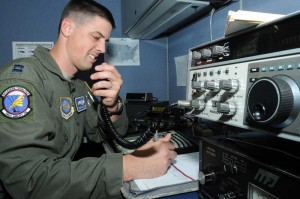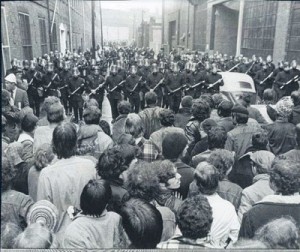by Kevin Driscoll
In January, Make announced a grant from the Defense Advanced Research Projects Agency (DARPA) to establish DIY workshops in 1000 high schools over the next four years. These “makerspaces”, stocked with tools and staffed with mentors, aim to provide teens with hands-on experience building and modifying new technologies. Founders describe the ideal makerspace as a combination of existing institutions: the shop class, computer lab, and school library. Drawing on the norms and values of the maker movement, the program emphasizes self-directed learning and encourages students from different schools to connect online.
Although Make magazine and many of the products in Make’s online shop are descendants of an earlier generation of DIY tinkerers that grew up reading Popular Electronics and building Heathkits, the larger “maker” movement draws equal inspiration from the mythical hacker counter-culture of the 1970s. As you might imagine, the hacker side of this equation is unsettled by the influx of military money. Representing the most upset faction, a group named Demilit–“we study the spatial/social/political conditions produced by militarization”–assembled a storified polemic accusing the Makerspaces program of “making killer geeks.” But what is DARPA and why would it fund “makerspaces” in the first place? Aren’t there more efficient ways to build war machines than to dump LEDs and Arduinos on a few thousand unsuspecting high schoolers?
Formed in 1958, in the wake of the Sputnik launch (and the fire it lit under the postwar spirit of American exceptionalism,) DARPA is best known for funding a number of research projects throughout the 1960s and 70s that collectively produced the theoretical and technological foundation for networked personal computing. With cybernetician J. C. R. Licklider writing the checks, DARPA funded Bob Taylor and Xerox PARC, Douglas Engelbart and the Augmentation Research Center, and a number of other labs where you might find a computer desk designed for someone sitting in the lotus position.
Of course, for every internet there’s a Skynet. DARPA funding also contributes to the production of mass-scale surveillance systems, unmanned drones for the sea/land/air/space, and the Terminator’s best friend, a quadruped robot called “BigDog.”
“BigDog climbs in the woods, keeps its balance when kicked and when slipping on ice, travels through snow and mud, jogs 5 mph, and climbs some rubble.” — BostonDynamics YouTube Channel
Although DARPA has mined various DIY/hacker/maker cultures for talent and ideas since its inception, the relationship has never been an easy one. During the Vietnam war, demonstrators across the country specifically targeted campus research labs that received military funding. Many of the students and faculty working in computing were drawn to the field by the peaceful promises of group communication, access to information, and human augmentation–ideals that also made them sympathetic to the anti-war movement. John Markoff reported some Stanford grad students resigned from Engelbart’s lab because of a moral conflict with the DARPA funding, and M. Mitchell Waldrop found that other students justified the compromise by imagining themselves redirecting funds that would otherwise finance weapons manufacturing.
But the tense relationship between hobbyists and the military pre-dates DARPA and the 1960s counter-culture by another 50 years!
In the first years of the 20th century, very few people knew what to do with radio. A few “Marconi stations” used wireless telegraphy to transmit news, and the Navy adopted radio for maritime communication, but the lion’s share of wireless communication was carried out by hobbyists running systems built from scrap wire and discarded telegraph parts. Before the term “amateur radio” was even in use, hobbyist radio operators were routinely blamed for interfering with military and commercial communications. Following public outcry over the Titanic disaster, amateur access to the airwaves was severely restricted and soon all radio operators were required to register with a newly-formed government agency.
Severely restricted, but not altogether squashed, the hobbyist radio operators realized that they had a public relations problem. Through the organization of clubs and amateur associations, the hobbyists began to speak with one voice about the public usefulness of amateur radio activity. “Hams” (as amateur radio operators are known) are helpful in times of natural disaster, they are entrepreneurial and work in high-tech businesses, and–crucial to the present discussion–hams are indispensable in times of war. Kristen Haring traced a symbiotic relationship between the military and DIY hobbies that began with radio in the 1910s and carries on to the present day. During the first world war, the military began to recruit amateur radio operators because they were much easier to train. Those who were fortunate enough to survive the war, returned as more knowledgeable and skillful contributors to the amateur radio community. With the second World War, the process repeated itself, and on and on. Although the relationship protected the amateur radio operators from being regulated out of existence, the demands of remaining cozy with the military establishment cost them a certain degree of independence and limited the diversity of their membership.

A member of the Keesler Amateur Radio Club making contect on November 7, 2011. (U.S. Air Force photo by Kemberly Groue)
To some extent, the hams and the hackers represent twin histories converging in the nascent maker movement. And while their uneasy relationships with military money provide a helpful context for the Make/DARPA conflict, they do not fully explain the stakes. In multiple places, the founders of the Makerspaces project refer to a comment by Dr. Regina Dugan, former Director of DARPA as evidence that DARPA and the maker movement share similar goals: “One of the biggest challenges we face as a nation is the decline in our ability to make things.” In a blog post from April responding to critics, Dale Dougherty from Make also points out the long-running relationship between DARPA and MIT–an institution “known to produce more than a few hackers”–as evidence that DARPA is not simply “co-opting” maker culture but is an integral part of its history. Dougherty emphasizes that Make can work with DARPA because of a shared hope that students exposed to hands-on/DIY activities in school will be more likely to become scientists and engineers that “tackle important problems and find creative solutions that benefits all of us.”
As the first generation of DARPA-funded Makerspaces gets underway, it will be interesting to monitor the schism in the maker community. As the hams and the hackers demonstrate, there are costs and benefits to cavorting with the military industrial complex. The novel challenge that faces today’s makers, however, is the systematic defunding of public education: extracurricular activities cut, curriculum design constrained by standardized testing, and teachers overworked and underpaid.
We know that hacking, making, and DIY can fundamentally transform a young person’s relationship to their material world, but what would a cynic call a makerspace in a school that can no longer afford to keep the shop class, the computer lab, and the library open? Downsizing.



